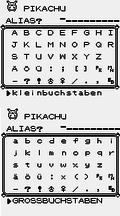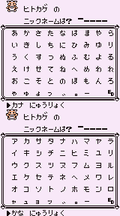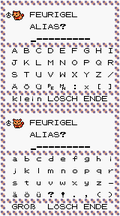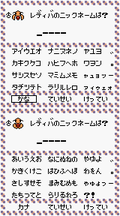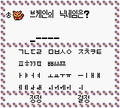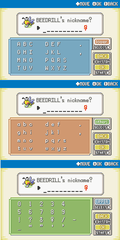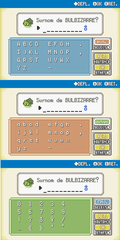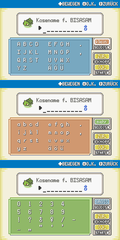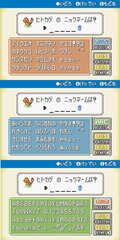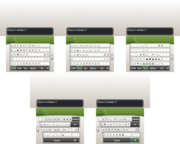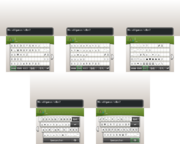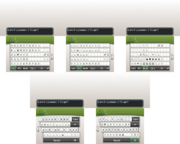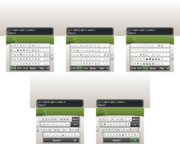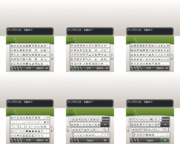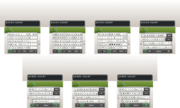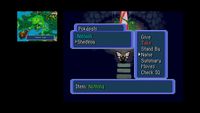Nickname

|
The contents of this article have been suggested to be split into Text entry in the Pokémon games. Please discuss it on the talk page for this article. |

A nickname (Japanese: ニックネーム nickname) is a name given to a Pokémon by its Original Trainer. Every time a player catches, hatches, or is given a new Pokémon in a core series game, he or she is able to nickname the Pokémon to a maximum of six characters in Japanese, Korean, and Chinese and twelve characters in Western languages (five and ten, respectively, prior to Generation VI). In addition to the games, nicknamed Pokémon have also been shown in the Pokémon anime and several manga series. Nicknames serve as a means of personalizing one's Pokémon, and distinguishing them from other individuals of the same species.
In the games
Players are given the option to nickname their Pokémon immediately after receiving them in any manner, such as receiving it from an NPC, hatching from an Egg, or capturing in a Poké Ball. The only way to change a Pokémon's nickname is by taking the Pokémon to a Name Rater, and the Name Rater will refuse to change the nickname of a Pokémon if the player is not that Pokémon's original Trainer.
In Generation V and VII, tapping the Pokémon's sprite on the nickname screen replaces the currently entered text with the Pokémon's species name. In Generation VI, this replaces the currently entered text with the Pokémon's current nickname, or its species name if it has not been nicknamed.
Limits on nicknames
In Generation I to V, nicknames have a maximum length of 10 characters in Western languages and 5 characters in Japanese and Korean. Starting in Generation VI, nicknames have a maximum length of 12 characters in Western languages and 6 characters in Japanese and Korean.
These characters are in turn limited by the character palette in the games, which varies between game languages. The characters available have expanded over the generations: in Generation I it was impossible to use numbers in nicknames, while later generations allowed both numbers and non-alphanumeric symbols.
In Generation I, a name consisting of only spaces can be used. In subsequent generations, this is treated as entering no nickname: a newly obtained Pokémon will use its species name, and a Pokémon at the Name Rater will keep its current name.
Pokémon can only have their nickname changed by their original Trainer; if an outsider Pokémon cannot be moved to its original Trainer's game, it cannot be renamed at all. If an outsider Pokémon is taken to a Name Rater, he will say the name is "perfect" and refuse to change it. The game checks the original Trainer name, gender (Generation III onward), Trainer ID number, and Secret ID (Generation III onward).
In the Generation III games, a Pokémon named in a Western game traded to a Japanese game will have its name rendered in fullwidth characters, making it impossible to display the full name if it is longer than five characters.
In the 1.0 release of the English versions of Pokémon Ruby and Sapphire, the nickname flag of Japanese Pokémon is not set when they evolve, so the Pokémon's species name will be adjusted accordingly (e.g.: Pichu's Japanese species name is ピチュー and the player nicknames it PICHU, then trades it to an English version and evolves it, causing its name to become PIKACHU). However, since the English games still render the name in the Japanese font, an evolved Japanese Pokémon that has a name longer than five characters will cause a crash while attempting to load the Pokémon List or send it out to battle (in the aforementioned case, the game will try to render it as PIKACHU instead of PIKACHU). This was fixed in the 1.1 release by adding an additional check to the name function used during evolution so that the Japanese Pokémon's name is not altered, effectively treating it as if it were a nickname. The European releases and subsequent Generation III games also have this check.
In Generation IV and later games, non-nicknamed Pokémon with a language of origin different to their current game will update their name to their current game's language upon evolution.
In Pokémon Colosseum and Pokémon XD, a Shadow Pokémon cannot be nicknamed if it has not been purified. Immediately after this happens, the option will be given. Wild Pokémon caught from a Poké Spot in Pokémon XD can be nicknamed as they are normally in the core series.
From Generation V onward, the game will recognize when a nickname is profanity, and will not allow the player to use this as a nickname. The Generation V games contain an internal list of censored words which only censors case-insensitive matches. The Generation VI and VII games use the Nintendo 3DS system's built-in filter, which uses regular expressions to censor a wide range of attempts to circumvent it. If a Pokémon transferred via Poké Transfer has a nickname that would not be permitted to be entered in Generation VI, the Pokémon's nickname is removed and it uses its species name instead.
In Generation V, nicknames the player enters can only contain up to 4 numeric characters. In Generation VI and VII, nicknames the player enters can only contain up to 5 numeric characters. However, Pokémon transferred from previous generations can violate these limits, and their names will not be changed upon transfer.
Outcomes of nicknaming
Nicknaming Pokémon rarely has any effect on gameplay, and is simply an element of customization that players are free to use or ignore. The only games in which nicknamed Pokémon are treated differently are Pokémon Stadium and Pokémon Stadium 2. In these games, when nicknamed Pokémon are transferred from a core series game they have a chance of being alternately colored. This coloration is not the same as being a Shiny Pokémon. This feature has not been included in any later games.
Sometimes, in Pokémon Ruby, Sapphire, and Emerald, when the player gives a previously caught Pokémon a nickname at the Name Rater's house, the Hoenn TV network will report the nickname chosen. The host will always commend the player on his or her choice of name, even if the player decides to leave the Pokémon's name as it was. When records have been mixed with another save file, the television network may report on the other Trainer's choice of nicknames.
With Generation IV's Global Trade System, some naming issues may arise. The main issues are receiving Pokémon with nicknames in a foreign language and receiving Pokémon whose nicknames are threatening, inappropriate, racist, vulgar or pointless (for example, a name consisting of random characters). As the chances of matching both the Trainer ID and Secret ID are near impossible, these nicknames cannot be changed.
In Pokémon Black 2 and White 2, there is a Medal awarded for having nicknamed Pokémon 10 times.
Pokémon with nicknames deemed "inappropriate" may show up in Battle Videos as Pokémon without a nickname: a Staraptor named inappropriately would have its nickname reverted to "STARAPTOR". It is unknown if this censoring is automatic or done on a case-by-case basis by Nintendo employees.
In Pokémon Omega Ruby and Alpha Sapphire, a BuzzNav program called The Name Rater Show tells a Pokémon's fortune based upon the first letter of its nickname.
Non-player characters and nicknames
NPC-nicknamed Pokémon are somewhat rare, and almost never encountered in battles. However, all Pokémon acquired from in-game trades have nicknames, as well as all Pokémon used by NPC Coordinators prior to Generation VI. Likely to emphasize the color change effect, most of the Pokémon encountered in Pokémon Stadium also have nicknames. Team Rocket's nicknamed Pokémon have numbers in their nicknames (which was impossible on hand-held games at the time).
In Black and White, the player can trade a PetililW or CottoneeB to Lass Dye for the opposite Pokémon in Nacrene City. If the player returns to her after defeating Ghetsis at the end of the game, they can battle her, and she will use the player's former Pokémon, now fully evolved. If this Pokémon was given a nickname by the player before being traded, it will appear with the nickname in this battle, marking the first time in the main series that the player can battle a nicknamed Pokémon used by an NPC.
In Black 2 and White 2, due to NPC and player switching one of their Pokémon in PWT's Mix Tournament, it is possible to fight a nicknamed Pokémon if the Pokémon chosen by opponent had a nickname.
In Pokémon Sun and Moon, Lillie carries around a Cosmog she calls "Nebby". While battling against it after it evolves into either SolgaleoS or LunalaM, it is not nicknamed, and upon catching it, the player is given a chance to nickname it.
Nicknames for the player
In Pokémon X and Y, the player is referred to by a nickname by Calem/Serena, Shauna, Tierno, and Trevor. The player can choose from three suggestions, based on the first two characters of the player's name if playing in Japanese or the first character if playing in other languages, or enter a nickname of their own choice.
For example, a male player named "Calem" could choose from "Li'l C", "C-Meister", "Big C", or a nickname of their choice in the English versions of X and Y.
| Language | Male | Female |
|---|---|---|
| Japanese | <chars>タロ <chars>-taro <chars>やん <chars>-yan <chars>P <chars>-P |
<chars>っち <chars>-tchi <chars>ーな <chars>-na <chars>りん <chars>-rin |
| English | Li'l <char> <char>-Meister Big <char> |
Li'l <char> Lady <char> <char>-kins |
| French | P'tit <char> Mister <char> Sieur <char> |
P'tite <char> Miss <char> Dame <char> |
| German | Mini-<char> Monsieur <char> Lord <char> |
Mini-<char> Madame <char> Lady <char> |
| Italian | Super <char> Mr. <char> Magico <char> |
Super <char> Lady <char> Magica <char> |
| Spanish | Peque <char> Super-<char> Mr. <char> |
Peque <char> Super-<char> Lady <char> |
| Korean | <char>군 <char>-gun <char>돌이 <char>-dori 미스터 <char> Mister <char> |
<char>양 <char>-yang <char>순이 <char>-suni 스위트 <char> Sweet <char> |
List of characters
Generation I
Generation II
Compared to Generation I, gender symbols were removed from the Western versions, while the space and semicolon were also removed from the German version. The kana を / ヲ wo, small vowel katakana, question mark, and exclamation mark were added to the Japanese version.
Generation III
Compared to Generation II, the ability to type digits, gender symbols, and ellipsis were added to all versions. The ability to type the multiplication symbol, parentheses, colon, square brackets, and the Pokémon abbreviation were removed, while the ability to type single quotation marks was added to the Western versions. The semicolon was also removed from the English, French, Italian, and Spanish versions.
Double quotation marks were added to the English, Italian, and Spanish versions. Double guillemets were added to the French version. The space, the uppercase and lowercase letters ä, ö, and ü, and double quotation marks were added to the German version. Uppercase and lowercase Latin alphabet letters, small vowel hiragana, fullwidth period, interpunct, double and single quotation marks, and slash were added to the Japanese version.
Generation IV
Compared to Generation III, the ability to type the colon, semicolon, parentheses, tilde/wave dash, at sign, percent sign, plus sign, equals sign, ten shapes, music note, cloud, umbrella, snowman, four faces, sleeping symbol, and two arrows were added to all versions. The multiplication sign, division sign, fullwidth comma, halfwidth period, comma, and hyphen-minus were added to the Japanese version, while the interpunct, number sign, and asterisk were added to Western and Korean versions.
Double quotation marks, the uppercase and lowercase letters à, ç, é, è, ù, and û, and the lowercase letters â, ê, ë, î, ï, and ô were added to the French version. The right double quotation mark (”) and ß were added to the German version. The letters à, é, è, ì, ò, and ù were added in uppercase and lowercase to the Italian versions. The inverted exclamation and question marks and the letters á, é, í, ñ, ó, ú, and ü were added in uppercase and lowercase to the Spanish versions.
Compared to Generation II, the ability to type uppercase and lowercase Latin alphabet letters, digits, exclamation mark, and question mark were added in the Korean versions.
Generation V
Compared to Generation IV, only the at sign has been removed from Western and Korean versions. The uppercase letters Â, Ê, Ë, Î, Ï, Ô, and Û were added to the French version, while the ability to enter the katakana ヴ vu was added to the Japanese version.
Generation VI and VII
Compared to Generation V, only the at sign has been removed. The uppercase and lowercase é were added to the English and German versions, while the letters ç, ï, à, è, ì, ò, and ù were added in uppercase and lowercase to the Spanish version.
No changes in character availability were made between Generation VI and VII.
In spin-off series

|
This section is incomplete. Please feel free to edit this section to add missing information and complete it. Reason: needs all series where it's possible |
Pokémon Channel
In Pokémon Channel, the player has the option to nickname his or her companion, Pikachu, once they become familiar enough with each other.
Pokémon Mystery Dungeon series
In the Pokémon Mystery Dungeon series, the player has the option to name the player and their partner and at the beginning of the games, which defaults to their Pokémon. Later in-game the player and partner forms a team which they name, this name cannot be changed in Red Rescue team and Blue Rescue Team but can be changed starting from Explorers of Time and Darkness at any time from the main menu.
Prior to Pokémon Super Mystery Dungeon, the player can name any Pokémon that joins their team upon recruitment. In Explorers of Time, Darkness, and Sky and Gates to Infinity, they can also name a Pokémon when it evolves. In Red Rescue Team and Blue Rescue Team, Shedinja can be nicknamed at any time, a property unique to it.
In Pokémon Super Mystery Dungeon, only the player and partner can be named. Their names can be changed at any time, along with their team name, from the main menu.
Other than the cases specifically mentioned, there is no way to change nicknames.
List of characters

|
This section is incomplete. Please feel free to edit this section to add missing information and complete it. Reason: needs Japanese and Korean characters and WiiWare, images |
Rescue Team and Explorers
There were no changes between Rescue Team and Explorers except the positioning of the characters Š and Þ, and Ý and Ÿ which were swapped and þ which were positioned after ž in Rescue Team.
|
Gates to Infinity
In Gates to Infinity, space is blank instead of using a bottom square bracket, Ellipsis was moved to after the lowercase letters, and the Single low-9 quotation mark, Left single quotation mark, Double low-9 quotation mark, and the Left double quotaion mark were added.
|
Super Mystery Dungeon
The only change in Super Mystery Dungeon is that space went back to using a bottom square bracket instead of a blank.
|
Pokémon Ranger series

|
This section is incomplete. Please feel free to edit this section to add missing information and complete it. Reason: needs other languages if different and what is on the third screen |
In the Pokémon Ranger series, the player can be named at the beginning of the game.
List of characters
Pokémon Ranger
|
Shadows of Almia and Guardian Signs
|
Pokémon Trozei series
In Pokémon Trozei! the player is named at the beginning of the game and can change this name at any time from the main menu.
List of characters
|
Pokémon Art Academy
In Pokémon Art Academy, the player selects a name for themselves at the beginning of the game. The player can change their name as well as the name of any card in their album at any time.
The game utilizes the 3DS's keyboard and its limitations. Cards' names can be left blank.
Pokémon GO

|
This section is incomplete. Please feel free to edit this section to add missing information and complete it. Reason: are there any characters that Pokémon GO does not support? |
In Pokémon GO, the player selects a name for themselves at the beginning of the game, and can only change it once by going to the settings and pressing Change Nickname.
Caught Pokémon can have a nickname assigned or changed on the Pokémon's summary screen by tapping its name. Nicknames can be up to twelve characters long. Nicknames are not visible to other players. Pokémon GO uses rich text entry, which allows bold tags (<b></b>) and italic tags (<i></i>) to be used; other tags supported by Unity's rich text system are too long to enclose any text.
All text entry uses the keyboard of the device the game is played on.
Pokémon Duel
In Pokémon Duel, the player selects a name for themselves at the beginning of the game.
Names can be up to eight characters long.
All text entry uses the keyboard of the device the game is played on.
In the anime
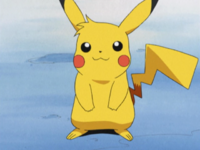
As in the games, nicknaming Pokémon is optional. It is very seldom that main characters have nicknamed their Pokémon, leaving nicknaming largely unique to one-time characters. Often, these characters possess more than one of a species of Pokémon, and nicknaming is to provide distinction, such as in Get Along, Little Pokémon. At other times, the nicknames help to drive the plot, as in Wherefore Art Thou, Pokémon.
The only main characters to possess a nicknamed Pokémon are Misty, who has a Luvdisc known as Caserin, and James, who has a Growlithe called Growlie. Ritchie, a recurring character, also uses nicknames. Marina from The Legend of Thunder! and Mairin from Mega Evolution Special I also have nicknamed Pokémon.
Nicknamed Pokémon still say their species name as their cry in the anime instead of their nickname. For example, Sparky still says "Pikachu" and variants of it.
Bonnie, who was a travelling companion of Ash, nicknamed a Zygarde Core, Squishy in the XY series.
In the manga
Some Pokémon manga series use nicknames as a way to differentiate and individualize Pokémon characters.
In the Pokémon Adventures manga
At least two Pokédex holders in each region name their Pokémon. Quite often, the Trainer will nickname his or her Pokémon with a particular pattern, such as how Crystal ends most of her Pokémon's nicknames with the "ee" sound, and Gold ends most of his Pokémon's names with "bo". Several other characters nickname their Pokémon as well; for example, Brock's six Geodude are each named after a number, from "Geoone" to "Geosix".
Unlike in the games, nicknames of owned Pokémon can be changed when the owner of the Pokémon is changed. Examples of this include Mr. Stone's Castform being named Fofo by Ruby, Gurkinn's Gengar being named Garma by X, and Grace's Rhyhorn being named Saisai by Y. Also, nicknames may be removed by the new trainer, as Silver's Kingdra was nicknamed Tat-chan when she was under Green's ownership.
In other languages
| ||||||||||||||||||||||||||||||||||||||
| Pokémon training | |
|---|---|
| Catching • Nicknaming • Battling • Evolving • Trading • Breeding • Releasing | |


